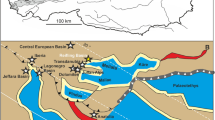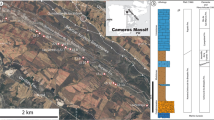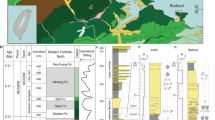Abstract
GROUND sloths (Gravigrada, Xenarthra) are known from middle or late Oligocene to late Pleistocene in South America1 and from late Miocene to late Pleistocene in North America2. They are medium to gigantic in size and have terrestrial3 habits. Discovery of abundant and well preserved remains of a new sloth (Thalas-socnus natans), in marine Pliocene deposits from Peru4–6 drastically expands our knowledge of the range of adaptation of the order. The abundance of individuals, the absence of other land mammals in the rich marine vertebrate fauna of the site5,6, and the fact that the Peruvian coast was a desert during the Pliocene7,8 suggest that it was living on the shore and entered the water probably to feed upon sea-grasses or seaweeds. The morphology of premaxillae, femur, caudal vertebrae (similar to those of otters and beavers) and limb proportions are in agreement with this interpretation.
This is a preview of subscription content, access via your institution
Access options
Subscribe to this journal
Receive 51 print issues and online access
$199.00 per year
only $3.90 per issue
Buy this article
- Purchase on Springer Link
- Instant access to full article PDF
Prices may be subject to local taxes which are calculated during checkout
Similar content being viewed by others
References
Marshall, L. G. & Cifelli, R. L. Palaeovertebrata 19, 169–210 (1990).
Webb, D. in The Great American Biotic interchange (eds Stehli, G. & Webb, D.) 357–386 (Plenum, New York, 1985).
White, J. J. vert Paleont. 13, 230–242 (1993).
Hoffstetter, R. C. r. hebd. Séanc. Acad. Sci., Paris D267, 1273–1276 (1968).
Muizon, C. de Ed. Rech. gr. Civilisations, mém. 6, 1–150 (Trav. Inst. Fr. Et. Andines 22) (1981).
Muizon C. de & DeVries, T. J. Geol. Rdsch. 74, 547–563 (1985).
Alpers, C. N. & Brimhall, C. H. Geol. Soc. Am. Bull. 100, 1640–1651, (1988).
Sébrier, M., Marocco, R. & Macharé, J. in Montagnes et Piedmonts 49–69 (Revue Géographique des Pyrénées et du Sud-Ouest, Spec, issue, Toulouse, 1984).
Muizon, C. de & Bellon, H. C. r. hebd. Séanc. Acad. Sci., Paris D290, 1063–1066 (1981).
Muizon, C. de & Bellon, H. C. r. hebd. Séanc. Acad. Sci., Paris 303, 1401–1404 (1986).
Cartelle, C. & Fonseca, J. S. Lundiana 2, 127–181 (1983).
Paula Couto, C. Tratado de Paleomastozoologia (Acad. Bras. Ci., Rio de Janeiro, 1979).
Frailey, C. D. Contr. Sci. Nat. Hist. Mus. L. A. Co. 374, 1–46 (1986).
Stock, C. Publs Carnegie Instn 331, 1–206 (1925).
Muizon, C. de Ed. Rech. Civilisations, mém. 50, 1–188 (Trav. Inst. Fr. Et. Andines 27) (1984).
Muizon, C. de Ed. Rech. Civilisations mém. 78,, 1–244 (Trav. Inst. Fr. Et. Andines 42) (1988).
Muizon, C. de Nature 365, 745–748 (1993).
Marocco, R. & Muizon, C. de Bull. Inst. Fr. Et. Andines 27, 105–117 (1988).
Cartelle, C. & Bohorquez, G. A. Iheringia 11, 9–14 (1986).
Solounias, N., Teaford, M. & Walker, A. Paleobiology 14, 287–300 (1988).
Hansen, R. M. Paleobiology 4, 302–319 (1978).
Naples, V. Contr. Sci. Nat. Hist. Mus. L.A. Co. 389, 1–21 (1987).
Paula Couto, C. Annls. Acad. brasil Cienc. 43 (suppl.), 499–513 (1971).
Owen, R. Description of the Skeleton of an Extinct Gigantic Sloth, Mylodon robustus, Owen, with Observations on the Osteology, Natural Affinities, and Probable Habits of the Mega-theroid Quadrupeds in General (R. & J. Taylor, London, 1842).
White, J. L. J. vert. Paleont. 13, 230–242 (1993).
Miller, M. E., Christensen, G. C. & Evans, H. E. Anatomy of the Dog (Saunders, Philadelphia, 1964).
Hoffstetter, R. Traité de Paléont. VI, 522–636 (Masson, Paris, 1958).
Mones, A. Cour. Forsch.-Inst. Senckenberg 82, 1–625 (1986).
Patterson, B., Segall, W., Turnbull, W. D. & Gaudin, T. J. Fieldiana Geol. 24, 1–79 (1992).
Author information
Authors and Affiliations
Rights and permissions
About this article
Cite this article
Muizon , C., McDonald, H. An aquatic sloth from the Pliocene of Peru. Nature 375, 224–227 (1995). https://doi.org/10.1038/375224a0
Received:
Accepted:
Issue Date:
DOI: https://doi.org/10.1038/375224a0
This article is cited by
-
Isotope data from amino acids indicate Darwin’s ground sloth was not an herbivore
Scientific Reports (2021)
-
Late Neogene evolution of the Peruvian margin and its ecosystems: a synthesis from the Sacaco record
International Journal of Earth Sciences (2021)
-
Evolutive Implications of Megathericulus patagonicus (Xenarthra, Megatheriinae) from the Miocene of Patagonia Argentina
Journal of Mammalian Evolution (2020)
-
The Hind Limbs of Sobrarbesiren cardieli (Eocene, Northeastern Spain) and New Insights into the Locomotion Capabilities of the Quadrupedal Sirenians
Journal of Mammalian Evolution (2020)
-
The Postcranial Musculoskeletal System of Xenarthrans: Insights from over Two Centuries of Research and Future Directions
Journal of Mammalian Evolution (2018)
Comments
By submitting a comment you agree to abide by our Terms and Community Guidelines. If you find something abusive or that does not comply with our terms or guidelines please flag it as inappropriate.



